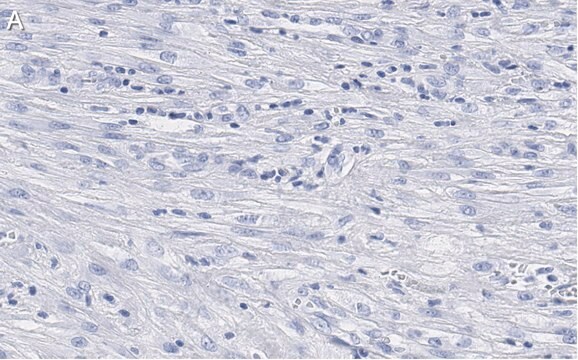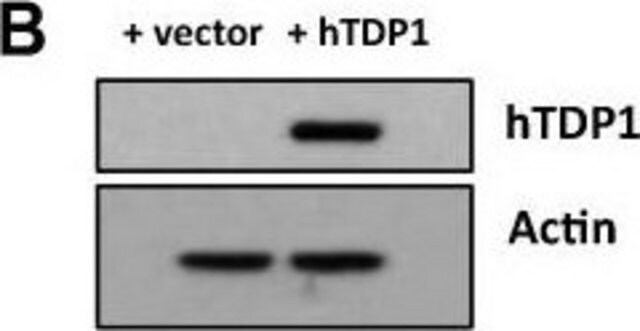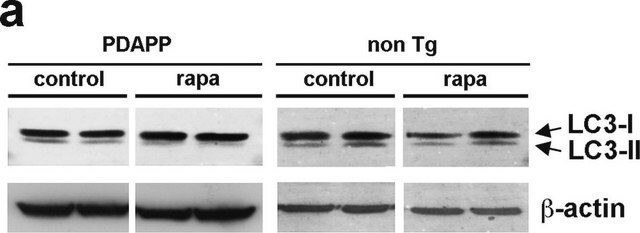General description
Actin is a highly conserved protein that is a major component of both the cytoskeletal and contractile structures in all cell types. It varies in amount, being related to the type of differentiation and to the functional state of cells and tissues. Actin can be found in two different forms of aggregation, the globular or the fibrillar state, and at least six distinct isoforms occur in vertebrates. The actins exhibit over 90% sequence homology, but each isoform has a unique NH2-terminal sequence. The isoforms are comprised of three α actins (skeletal, cardiac, smooth), one β actin (β-non-muscle) and two γ actins (γ smooth muscle and γ non-muscle). ACTB (actin β) gene codes for β-actin. It is a cytoskeletal housekeeping protein. It is present in the cytoplasm. The ACTB gene is located on human chromosome 7p22.1.
Monoclonal Anti-β-Actin (mouse IgG2a isotype) is derived from the AC-74 hybridoma produced by the fusion of mouse myeloma cells and splenocytes from an immunized mouse.
Recognizes an epitope located on the N-terminal end of the β-isoform of actin. It specifically labels β-actin in a wide variety of tissues and species. In immunofluorescent staining of chicken gizzard ultrathin cryosections, the antibody labels the dense bodies, the longitudinal channels linking consecutive dense bodies that are also occupied by desmin and the membrane-associated dense plaque. The antibody does not react with adult cardiac or skeletal muscle (besides traces due to contamination of the sample with non-muscle cells) or with β-actin expressing cells in Dictyostelium discoideum amoeba. The epitope recognized by the antibody is resistant to formalin-fixation and paraffin-embedding. B5, methacarn, ethanol or Bouin′s solutions may be also used as fixatives. The antibody can be used as probes for β-actin as an internal control in immunoblotting.
Immunogen
slightly modified β-cytoplasmic actin N-terminal peptide, Ac-Asp-Asp-Asp-Ile-Ala-Ala-Leu-Val-Ile-Asp-Asn-Gly-Ser-Gly-Lys, conjugated to KLH.
Application
Monoclonal mouse anti-actin antibody was used as a loading control for western blot analysis of immunoprecipitated proteins from rat dorsal root ganglion cocultures.
Monoclonal mouse anti-actin antibody was used as a loading control for western blot analysis of immunoprecipitated proteins from rat dorsal root ganglion cocultures.
Mouse Monoclonal Anti-β-Actin antibody has been used for western blot analyses. The antibody can also be used for immunohistochemistry, indirect immunofluorescence (1:1,000) using cultured human or chicken fibroblasts, and indirect ELISA.
Western blot analysis of MDCK cell lysates were performed using monoclonal anti-actin antibody as a primary antibody.
Monoclonal Anti-β-Actin antibody has been used in western blotting.
Mouse Monoclonal Anti-β-Actin antibody has been used for western blot analyses. The antibody can also be used for immunohistochemistry, indirect immunofluorescence (1:1,000) using cultured human or chicken fibroblasts, and indirect ELISA.
Western blot analysis of MDCK cell lysates were performed using monoclonal anti-actin antibody as a primary antibody.
Biochem/physiol Actions
The two major cytoskeletal proteins implicated in cell motility are actin and myosin. Actin and myosin are constituents of many cell types and are involved in a myriad of cellular processes including locomotion, secretion, cytoplasmic streaming, phagocytosis, and cytokinesis. β-Actin (ACTB) modulates cell growth, migration and the G-actin pool. Mutations in ACTB leads to pleiotropic developmental disorder. It recognizes an epitope located on the N-terminal end of the β-isoform of actin. It specifically labels β-actin in a wide variety of tissues and species. In immunofluorescent staining of chicken gizzard ultrathin cryosections, the antibody labels the dense bodies, the longitudinal channels linking consecutive dense bodies that are also occupied by desmin and the membrane-associated dense plaque. The antibody does not react with adult cardiac or skeletal muscle (besides traces due to contamination of the sample with non-muscle cells) or with β-actin expressing cells in Dictyostelium discoideum amoeba. The epitope recognized by the antibody is resistant to formalin-fixation and paraffin-embedding. B5, methacarn, ethanol or Bouin′s solutions may be also used as fixatives. The antibody can be used as probes for β-actin as an internal control in immunoblotting.
Physical form
The product is provided as ascites fluid containing 0.1% sodium azide as a preservative.
Storage and Stability
For continuous use, store at 2-8 °C for up to one month. For extended storage, solution may be frozen in working aliquots. Repeated freezing and thawing is not recommended. Storage in "frost-free" freezers is not recommended. If slight turbidity occurs upon prolonged storage, clarify by centrifugation before use.
Disclaimer
Unless otherwise stated in our catalog or other company documentation accompanying the product(s), our products are intended for research use only and are not to be used for any other purpose, which includes but is not limited to, unauthorized commercial uses, in vitro diagnostic uses, ex vivo or in vivo therapeutic uses or any type of consumption or application to humans or animals.

















